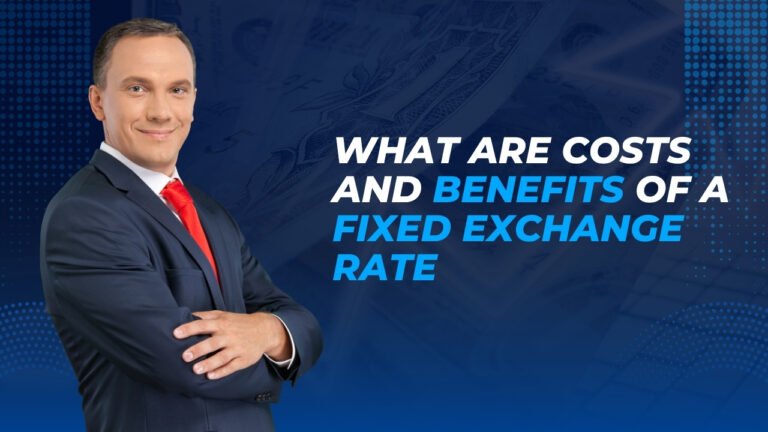Fixed Exchange Rate System: Costs & Benefits Explained Simply
Discover the pros and cons of a fixed exchange rate system. Learn how it works, when it benefits an economy, and the hidden costs you should know.
Table of Contents
The exchange rates determine the value of the currency of one country in relation to the other. Fixed exchange rate implies that the value of a currency is pegged or linked to another powerful currency, such as the US dollar. This system is stable, yet it has its trade-offs.
Traders, investors, and policymakers should understand the advantages and disadvantages of a fixed exchange rate. We at Beirman Capital strive to make such complicated subjects easy to understand so that even a novice learner can make informed choices. In this blog we are going to deconstruct how fixed exchange rates operate, when they are useful and where they can be problematic.
What Is a Fixed Exchange Rate?
Fixed exchange rate is a mechanism in which a nation pegs the value of its currency to that of another stable currency, which is usually the US Dollar (USD) or the Euro (EUR). This implies that the exchange rate does not fluctuate on a daily basis as in the floating systems. Rather, the central bank strives to maintain the rate at a constant level.
Assume that Country A fixes its currency at 1 USD = 10 of its local currency units. That rate remains the same regardless of what occurs in the market, unless the government chooses to alter it. In order to sustain this rate, the central bank intervenes by purchasing or selling foreign reserves as and when necessary.
This arrangement is quite contrasting to a floating exchange rate where the value of currencies fluctuates depending on supply, demand, and market news. The USA or the UK are countries that adhere to floating systems, whereas others, particularly smaller or export-oriented economies, might prefer to adopt fixed rates in order to be more stable.
The concept of a fixed exchange rate is easy, predictability. It provides a stable environment to trade and invest, yet maintaining that stability is usually at a cost.
Benefits of a Fixed Exchange Rate
Choosing a fixed exchange rate can offer several advantages, especially for countries looking to maintain economic stability and boost investor confidence. Let’s look at the key benefits:
1. Currency Stability
Stability is one of the greatest advantages of a fixed exchange rate. It does not fluctuate up and down daily because the value of the currency is pegged on a strong foreign currency such as the USD. This simplifies the planning of costs and prices by businesses, importers and exporters.
2. Lower Inflation Risk
Countries can assist in controlling inflation by pegging the local currency to a stable currency. This is because they do not print excess money or allow prices to increase rapidly. This is particularly useful to those countries that have been experiencing inflation in the past.
3. Encourages Trade and Investment
Foreign investors and trading partners are more comfortable when the values of currencies remain stable. It minimizes the chances of unexpected losses as a result of exchange rate fluctuations. Consequently, additional firms might be ready to invest or conduct business with a nation that has a fixed exchange rate regime.
4. Builds Investor Confidence
A stable rate may be an indicator of good economic management. It demonstrates that the government is determined to maintain things stable. This has the potential of increasing investor confidence, particularly in developing or emerging economies.
5. Promotes Policy Discipline
Governments usually have to be more prudent in their expenditure and borrowing to maintain a fixed exchange rate. This may result in the creation of more responsible financial policies in the long run.
Costs or Drawbacks of a Fixed Exchange Rate
While fixed exchange rates offer stability, they also come with serious challenges. These costs can limit a country’s ability to respond to economic changes. Let’s explore the main drawbacks:
1. Limited Monetary Policy Control
The central bank becomes inflexible with a fixed exchange rate. It is not able to manipulate interest rates and money supply easily to react to the local economy. This implies that the country may not be free to act even in a slowdown or inflation.
2. Pressure on Foreign Currency Reserves
Central banks have to keep a lot of foreign currency (such as USD) to sustain the fixed rate. In case the market is pressuring the peg, the bank must sell or buy currency using its reserves. The system may collapse in case of low reserves.
3. Vulnerability to Speculation
Traders or investors can bet against the currency in case they feel that the fixed rate of a country is too high or too low. This speculative attack may compel the central bank to exhaust reserves and in case of loss of confidence, the country may be compelled to devalue or give up the peg.

4. Doesn’t Reflect Economic Reality
Fixed exchange rate does not necessarily reflect the true economic status of the country. When productivity declines or inflation increases and the currency remains fixed, the nation may lose its competitiveness in the international markets.
5. Risk of Trade Imbalance
When the fixed rate is high, it may render exports costly and imports high leading to a trade deficit. Conversely, an under-valued rate can cause inflation by importing basic commodities such as oil or food at high prices.
Fixed vs Floating Exchange Rate: Key Differences
Features | Floating Exchange Rate | Fixed Exchange Rate |
Definition | Currency value is determined by market forces (supply and demand) | Currency is pegged to another stable currency or a basket of currencies |
Exchange Rate Stability | Fluctuates frequently based on market conditions | Highly stable and Predictable |
Monetary Policy Flexibility | High – central bank has more control over domestic monetary policy | Limited – the central bank can’t freely change interest rates or money supply |
Inflation Control | Helps control inflation by tying to a stable currency | Inflation can vary depending on internal policies and economic trend |
Attracts Investment | May cause uncertainty for investors during volatile periods | Greater confidence for foreign investors due to currency stabilit |
Risk of Speculation | Less prone to speculative attacks on the currency | Higher if peg seems unsustainable |
Government Intervention | Minimal – market sets the exchange rate naturally | Frequent – central bank must actively maintain the peg |
Suitability | Works well for smaller, trade-reliant, or inflation-prone economies | Better for large, diversified, and stable economies |
Foreign Reserves Need | Low – no need to maintain large foreign currency reserves | High – reserves needed to defend the fixed rate |
Real Economic Reflection | Adjusts naturally to market and economic changes | May not reflect true market or economic value |
Real-World Examples of Fixed Exchange Rates
Many countries have used fixed exchange rate systems at different times, some with success, others facing challenges.
A well known example is Hong Kong. Since 1983, it has fixed its currency (HKD) to the US dollar at around 7.8 HKD per USD. The system works because Hong Kong has strong foreign reserves and a disciplined financial policy. It brings stability for trade and investors, especially in a highly global economy like Hong Kong’s.
On the other hand, Argentina tried a fixed exchange rate in thee 1990s by tying its peso to the US Dollar. At first, inflation dropped, and things looked good. But over time, economic problems grew, and the country couldn’t maintain the peg. In 2002, Argentina had to abandon the fixed rate, leading to a major currency crisis.
These examples show that while fixed exchange rates can offer stability and control, they only work well if a country has strong reserves, trust in policy, and a healthy economy.
When Does a Fixed Exchange Rate Work Best?
Fixed exchange rate system is most effective in some cases. It is particularly helpful to small or trade dependent nations that depend on stable prices of imports and exports. These countries can prevent abrupt exchange rate shocks that influence trade by maintaining the value of the currency.
It is also a good option to countries that are experiencing high inflation because pegging the local currency to a stable foreign currency (such as the US Dollar) will help in curbing the increase in prices and will also earn the trust of the people. In developing economies, fixed exchange rate may enhance the confidence of investors by demonstrating that the government is committed to economic stability.
A fixed rate is easier to control the economy and trade policies in areas where financial markets are still developing. But in order to have this system functioning effectively, the nation should possess good foreign reserves and economic policies.
Conclusion
A fixed exchange rate regime may provide stability, reduce inflation, and increase investor confidence, but it constrains the freedom of policy and needs large reserves. It is effective in some economies, particularly those that are trade-oriented or inflation-oriented. As with most financial instruments, it has trade-offs.
We at Beirman Capital feel that knowledge of such systems can assist traders and investors in making more intelligent decisions. Also if you are currency trading enthusiast and wanted to started your forex journey, open an account with us for trading diverse assets.
FAQs
1. What are the costs of a fixed exchange rate?
The primary disadvantages of a fixed exchange rate are the lack of control over monetary policy, the danger of currency attacks, excessive reserves and failure to depict real economic situations.
2. What are the benefits of a fixed exchange rate?
The advantages of fixed exchange rate are that the value of the currency is stable, inflation is reduced, increased trade and investment and increased confidence by investors and businesses.
3. What are the pros and cons of a fixed rate regime?
The advantages are stability of the currency, inflation and investor confidence. The drawbacks are the lack of policy control, the necessity to maintain large reserves, and the possibility of the lack of coordination with the actual economy.
4. What is the disadvantage of the fixed exchange rate method?
One of the major drawbacks of the fixed exchange rate system is that it restricts the capacity of a nation to change interest rates or react swiftly to economic fluctuations or crises.
5. 4 types of exchange rate system ?
Four categories of exchange rate systems are explained as follows:
- Fixed Exchange Rate: The value of the currency is pegged on another currency or a set of currencies.
- Floating Exchange Rate: Value of money will vary with the supply and demand in the market.
- Managed Float: It is mostly floating but the government at times comes in to manipulate the rate.
4. Pegged Float: The currency is weakly tied to another currency and will have a range of movement permitted within it.
6. Countries with fixed exchange rates?
Examples of countries that have fixed exchange rates are Hong Kong (pegged to the US Dollar), Saudi Arabia (pegged to the US Dollar), and the United Arab Emirates (also pegged to the US Dollar).
Get Complete Forex Trading Assistance


